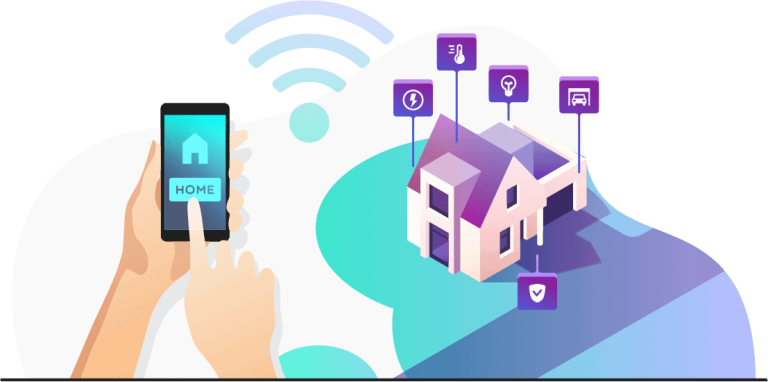
Home automation is the automatic control of electronic devices in your home. Because these devices are connected to the Internet, they may be operated from far. Devices can trigger one another with home automation, so you don’t have to operate them manually via an app or voice assistant. You can, for example, set your lights to turn off when you normally go to bed, or set your thermostat to turn on the A/C about an hour before you return to work so you don’t have to come home to a stuffy house. Home automation makes life easier and might even save you money on utility expenses such as heating, cooling, and electricity. With Internet of Things devices like security cameras and systems, home automation can also lead to increased safety. But wait, what exactly is the Internet of Things?
The Internet of Things, or IoT, refers to any equipment that isn’t ordinarily connected to the Internet, such as a smart light bulb that can be turned on and off via an app. All home automation devices are Internet of Things (IoT) devices that can be programmed to trigger each other. While IoT refers to the devices themselves, home automation refers to the things you can do with them to make your life a little easier.

Home automation is accomplished by a network of devices connected to the Internet via various communication protocols such as Wi-Fi, Bluetooth, ZigBee, and others. The devices can be controlled remotely via electronic interfaces, such as a voice assistant like Alexa or Google Assistant or an app. Many of these IoT devices include sensors that track changes in motion, temperature, and light to provide information about the device’s surroundings to the user. The user activates actuators, which are physical mechanisms such as smart light switches, motorised valves, or motors that allow devices to be controlled remotely, to make physical changes to the device.
Monitoring refers to the ability for consumers to check in on their gadgets remotely via an app. Someone may, for example, see their live stream from a smart security camera.
Control refers to the user’s ability to operate these devices remotely, such as turning a security camera to see more of a living room.
Finally, automation entails programming devices to communicate with one another, such as having a smart siren sound whenever an armed security camera detects motion.
The control protocol is how IoT devices connect to the Internet and each other; if IoT devices were humans, the protocol would be their common language. Devices can communicate in a variety of languages, or protocols, similar to those used on Earth, including:
WiFi: WiFi is by far the most popular control protocol; it simply means that your IoT device will connect to the conventional Internet through your ISP. While this does not necessitate the use of an additional hub, keep in mind that it may slow down your web browsing rates, especially if you have a lot of different IoT devices connected at the same time.
Z-Wave: Z-Wave is a low-power wireless technology that runs in the United States and Canada at 908.42 Mhz. It won’t interfere with your WiFi.
ZigBee: ZigBee is a mesh network and universal language that allows IoT devices to communicate, similar to Z-Wave.
Thread: Thread is a low-power, wireless mesh networking technology based on the IP address open standard that allows IoT devices to communicate with one another and with the cloud.
Bluetooth: Bluetooth is a mesh technology that allows individuals to control, monitor, and automate IoT objects and systems.
For most individuals, WiFi-connected devices will do, but for more advanced smart homes, a mesh network such as Z-Wave or ZigBee may be required.
Tricom is a smart automation solution provider headquartered in Singapore.
Interested to invest a smart home, hotel automation system, smart office or smart building system?
Drop us an email to info@tricom-int.com or WhatsApp +65 8756 0133.
Smart Solution Project Inquiry
Interested to invest a smart automation system to your properties? Drop us your inquiry.

32 Pekin St #05-01 Singapore 048762.
+65 8758 0133
info@tricom-int.com
Copyright © Tricom International Pte Ltd. All rights reserved.